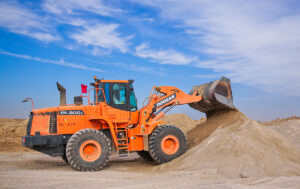The Center for Construction Research and Training (CPWR) released a new hazard alert to help prevent silica dust exposure among construction and surface mining workers who operate mobile equipment in enclosed cabs.
Why is Silica Dust Deadly?
Respirable crystalline silica dust particles are so small, they are almost invisible when airborne.
Breathing in these particles can damage lungs—even small amounts over time can cause silicosis, lung cancer, or COPD.
Construction and surface mine workers who operate inside enclosed cabs can be especially at risk, as the silica dust is more potent such a small space with little ventilation.
How to Inspect Cabs for Issues Before Use
The CPWR advises in the hazard alert that cabs of mobile equipment should be examined for the following issue:
- The air filtration system: Inspect filters for damage or airflow bypass. Supervisors should be notified if the air filter needs to be cleaned or replaced.
- The cab structure: Inspect the cab daily for holes, gaps, and cracks around doors, windows, joints, power line entries, and controls. Use silicone caulk or rubber gaskets to repair and seal these areas. Supervisors should be notified if a door gasket or window seal needs to be replaced.
- Air pressure: Check the pressure gauge daily to ensure it works. Monitor the pressure throughout the work shift to make sure positive air pressure is maintained in the cab and dusty air is kept out.
Top Tips for Protecting Workers
Enclosed cabs can protect the operator from silica dust if it follows the following set of standards:
- Has a properly working air filtration system to keep it as free as possible from dust. The filter should have an efficiency rating of 95 percent or higher (e.g., MERC-16). A higher rating means less dust can penetrate the filter.
- Is positively pressured through the continuous delivery of fresh air. The pressure gauge in the cab should read between 0.05 – 0.25 inches of water (in.w.g. or in.H2O).
- Has a heating and cooling system with air circulation vents that create a one-directional air flow, with discharge vents above the equipment operator and pickup vents low in the cab.
- Has a communication system that lets the operator talk to other workers without opening the window or door.
- Is regularly cleaned and properly maintained, including closing mechanisms, gaskets, and door and other seals.
It’s important to note that workers and bystanders outside the enclosed cab can also be exposed. Water and/or dust suppressants can successfully reduce the exposure to silica dust and other dust.
Medical Surveillance Testing
Under the updated silica guidelines, all general industry and maritime employers must offer medical surveillance to employees who are exposed to the “action level” of 25 micrograms per cubic meter for 30 or more days a year.
Heavy metal screening can show if employees have been exposed to or affected by silica and other toxic substances. Medical surveillance testing is essential to help employees monitor the safety and health of employees—and take proactive steps to reduce exposure and become OSHA compliant.
Make medical surveillance easy with onsite testing that can come directly to you. Worksite Medical is a mobile medical unit staffed with licensed technicians that brings that lab to your worksite. Complete the form below to schedule and/or get your free quote!




